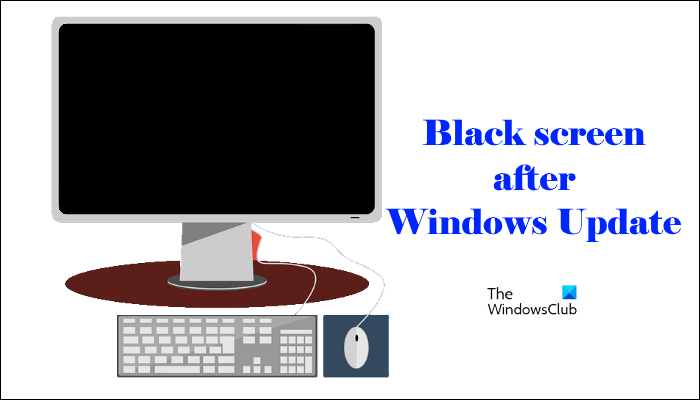Why is my PC screen black on Windows 11?
If your Windows 11/10 PC screen is black, your display driver might have been corrupted. You should boot into Windows Safe Mode and update your graphics driver from there. Another cause of this problem is the corrupted system image files. Also, check your monitor connections. It is also possible that the cable connecting your monitor is damaged.
How to fix Black Screen after Windows Update
If you see a Black Screen after Windows Update on your Windows 11/10 PC you will be in any one of the following situations:
Complete black screenA black screen with a mouse cursorFlickering black screen
In the first two cases, you have to troubleshoot your computer either in Windows Recovery Environment or in Safe Mode. If your screen flickers after installing Windows Update, your issue may be associated with the display drivers. Hence, updating them will help. Use the following solutions to fix the black screen issue after Windows Update. Let’s see all these fixes in detail.
Fix Windows Update black screen
1] Check your display cables (solution for Desktop users)
If you are a desktop user, it might be possible that your display is showing you a black screen due to loose connections or a faulty display cable. Check your display connections. If another computer is available, connect your monitor to that computer. This will let you know whether the issue is associated with your display or not. For this, you can also use your friend’s computer
2] Close the lid and open it again (solution for laptop users)
Laptop users can try this. Close your laptop lid and open it again. See if this resolves the issue or not.
3] Disconnect all external hardware
Sometimes, faulty hardware connected to a computer causes issues. You can check this by disconnecting all your external hardware devices. After disconnecting your hardware devices, force shut down your computer by pressing and holding the power button. After this, wait for a few minutes and turn on your computer. See if it resolves the issue.
4] Use a key combination to wake up your display
In Microsoft Windows operating system, you can wake up your display by using the Win + Ctrl + Shift + B key combination. Use this key combination and see if it helps.
5] Repair your system files
One possible cause of this problem is system file corruption after Windows Update. In some cases, Windows Update causes problems on a computer. We suggest you repair your system files. To do so, you have to enter Windows Recovery Environment. Because your display is black, you have to interfere with the normal startup process in Windows to enter the Recovery Environment. To do so, press and hold the power button to force shut down your computer. After that, turn it on again. When you see the Windows logo or your computer manufacturer’s logo, immediately press and hold the power button to force shit down your system again. Repeat this process until you see the Automatic Repair screen.
Now, follow the steps written below: In the Command Prompt, you will see the following: You have to select the drive on which Windows is installed. In most cases, it is the C drive. Hence, type the following command and hit Enter. Now, run SFC and DISM scans. After that, type exit in the Command Prompt and hit Enter to close it. Now, click Continue to restart your computer. This should fix the issue.
5] Update your display adapter
If you have tried all the above fixes but your display is still showing a black screen, the problem might be associated with your display driver. We suggest you update your display driver. To do so, you have to start your computer in Safe Mode via Windows Recovery Environment. Your screen should be visible in Safe Mode. Now, download the latest version of your display driver from the manufacturer’s website and install it. After installing the driver, restart your computer. Your problem should be fixed.
7] Perform System Restore or uninstall Windows Update
System Restore is a built-in tool in Windows computers that helps users restore their computers to the previous working state. You can use this tool if your system runs into a problem. That’s why it is recommended that System Restore should be enabled on your computer. When it is turned on, it automatically creates restore points so that you can use them to restore your system. Enter Windows Recovery Environment and go to the Advanced Options screen. We have already explained how to do that earlier in this article. Now, click System Restore and select the restore point that was created before you installed the Windows Update.
If System Restore via Windows RE fails or does not resolve the issue, you can uninstall the Windows Update. Again, you have to enter Windows Recovery Environment and go to the Advanced Options screen. Now, click Uninstall Updates. After you uninstall the update you may want to hide the problematic update.
8] Reset your PC
If none of the above solutions worked for you, resetting your PC will be the last option. Again, you have to use Windows Recovery Environment for resetting your PC. While using the Reset this PC option, select Keep my files if you do not want your data to be deleted.
Does Windows 11 have display issues?
No, Windows 11 does not have display issues. However, problems can occur on any machine. Hence, you may experience display issues on your computer irrespective of the operating system installed on it. Display issues usually occur due to the corrupted display driver and system image files. In some cases, it is a hardware issue. Read next: Screen stays black after waking the computer from Sleep Mode.

